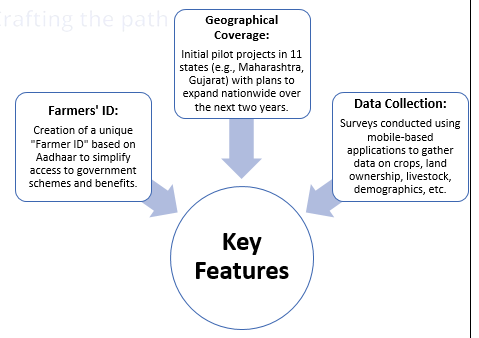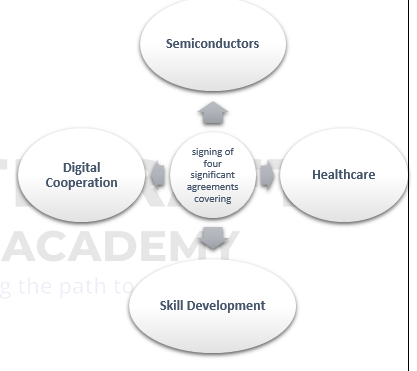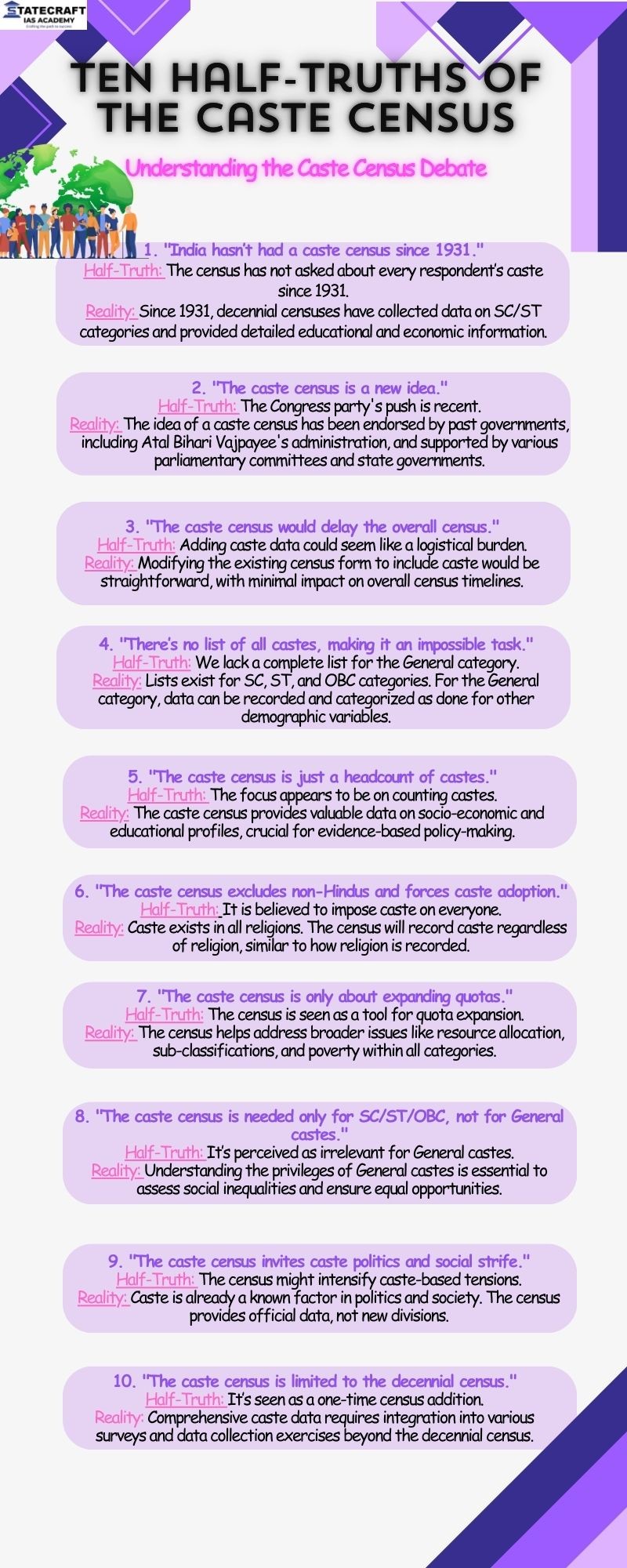1. 7 Newly Approved Schemes for Farmers
CONTEXT: The Union Cabinet has recently approved seven significant schemes for the agriculture sector, with a total outlay of ₹14,235.30 crore. Here’s a brief overview of these schemes:
Scheme | Details |
1. Digital Agriculture Mission (DAM): | o Outlay: ₹2,817 crore o Objective: Create a consolidated database linking various agricultural platforms and databases. |
2. Crop Science for Food and Nutritional Security:
| o Outlay: ₹3,979 crore o Objective: § Prepare farms for climate resilience. § Enhance food security by 2047. |
3. Sustainable Livestock Health and Production:
| o Outlay: ₹1,702 crore o Objective: § Increase income from livestock and dairy by improving livestock health and production. |
4. Sustainable Development of Horticulture:
| o Outlay: ₹1,129.30 crore o Objective: § Promote horticultural crops, including tropical, sub-tropical, and temperate crops. § Focus on root, tuber, bulbous, and arid crops, as well as vegetable, floriculture, and mushroom crops. |
5. Agricultural Education and Research:
| o Outlay: ₹2,291 crore o Objective: § Strengthen agricultural education, management, and social sciences. § Prepare agriculture students and researchers to address current and future challenges. |
6. Krishi Vigyan Kendras:
| o Outlay: ₹1,202 crore o Objective: § Strengthen the network of Krishi Vigyan Kendras to provide improved support and resources to farmers. |
7. Natural Resource Management: | o Outlay: ₹1,115 crore o Objective: Enhance the management of natural resources to support sustainable agricultural practices. |
2. Digital Agriculture Mission
CONTEXT: The Union Cabinet approved a ₹2,817-crore Digital Agriculture Mission for creating Digital Public Infrastructure (DPI) in the farm sector.
- Aims to consolidate data on farms, farmers, crops, and yields to improve agricultural productivity and governance.
Objectives:
1. Agristack:
| o Develop a digital platform integrating various farm-related databases. o Provides a unified view of agricultural resources, including crops, soil, and weather. |
2. Krishi Decision Support System (DSS):
| o Utilizes data to assist farmers in making informed decisions on crop management, weather forecasts, and market trends.
|
3. Soil Profile Maps:
| o Provides detailed information about soil health across various regions, aiding in better crop selection and soil management.
|
4. Digital General Crop Estimation Survey (DGCES): | o Aims to enhance the accuracy of crop production estimates using digital surveys and other technological tools.
|
Concerns:
- Data Accuracy:
- Questions raised about the precision of agricultural data, especially concerning crop production estimates.
- Privacy Issues:
- Concerns over data privacy and the potential misuse of collected information.
Benefits:
- Improved Decision-Making:
- Financial Inclusion:
Implementation Timeline:
The rollout is planned over 2024-25, with a gradual nationwide implementation following pilot success.
3. Constitution of the 23rd Law Commission
CONTEXT:
- The Centre has constituted the 23rd Law Commission for a period of three years.
- The term of the previous (22nd) Law Commission ended on August 31.
Composition:
- The Commission will have a full-time chairperson and four full-time members, including a member-secretary.
- It also includes ex-officio members: the Secretary of the Department of Legal Affairs and the Secretary of the Legislative Department.
Chairperson and Members:
- The chairperson and members can include serving judges of the Supreme Court and High Courts.
- These members will perform their functions on a full-time basis until their retirement from the judiciary or the expiry of the Commission’s term, whichever comes first.
- Their time spent in the Commission will be considered as “actual service.”
Remuneration:
- If persons from the “other category” (not serving judges) are appointed as chairperson or full-time members:
The 23rd Law Commission is set to continue the work of its predecessor in advising the government on legal reforms and addressing issues in the legal framework of the country.
4. Supreme Court's Stance on Demolition of Homes of Accused
- Supreme Court’s Query:
- The Supreme Court questioned the legality of demolishing homes and private properties of individuals accused of crimes, or even of their relatives, by the state.
- The court highlighted that the law does not permit such actions, even if the accused is convicted.
- Statement by Justice B.R. Gavai:
- Justice Gavai expressed concern over how a person’s home can be demolished simply because they are accused in a case, emphasizing that the law does not allow such measures.
- Senior Advocate’s Argument:
- Senior advocate Dushyant Dave, representing the petitioners, urged the court to prevent what he termed as “bulldozer justice,” ensuring it is not practiced anywhere in the country.
- Justice Viswanathan’s Indication:
- The court is considering laying down guidelines on a national level to standardize the procedure for taking action against unauthorized structures. These guidelines would ensure fair hearing and prevent the misuse of demolition powers as a form of retribution.
- Solicitor-General’s Defense:
- Solicitor-General Tushar Mehta defended the U.P. government, stating that demolitions occurred after proper statutory procedures. He denied any targeting of individuals or families as retribution, arguing that the demolitions were for illegal structures, some of which belonged to persons later found to be involved in crimes.
- Context of the Issue:
- The case brought attention to recent instances where states have been accused of demolishing properties as an act of public retribution against individuals accused of crimes.
Conclusion:
The Supreme Court is concerned with ensuring that demolitions are not used as a tool for retribution by the state, especially against those merely accused of crimes. The Court may establish guidelines to regulate the process and prevent potential misuse of power.
5. PM Modi’s Visit to Brunei and Singapore
Focus Areas:
- Trade and Technology: Strengthening trade ties and enhancing technological cooperation are the central themes of Prime Minister Narendra Modi’s visit to Brunei and Singapore.
Brunei:
- Meeting with Sultan Hassanal Bolkiah:
- PM Modi will meet the Sultan, the world’s longest reigning monarch, to discuss furthering space cooperation, building on the earlier 2018 agreement on satellite tracking.
- The two countries are expected to sign an MoU on space cooperation.
Singapore:
- Strategic Importance:
- Singapore is India’s 6th largest trading partner and a significant source of Foreign Direct Investment (FDI) in India.
- Officials highlighted Singapore’s role as a key player in the region’s trade, particularly in the context of the ASEAN-India Trade in Goods Agreement (AITIGA).
Regional Significance:
- Strategic Partnerships:
- The visit is seen as crucial for improving ties in the broader Indo-Pacific region, with a focus on enhancing India’s maritime and security cooperation.
- Energy Cooperation:
- India is looking to increase its LNG imports from Brunei, which has been a key supplier, especially amidst India’s efforts to diversify its energy sources.
Diplomatic Engagement:
- India’s Position in ASEAN:
- India’s focus on ASEAN is underscored by the significant agreements and strategic discussions planned during the visit.
- Historical Context:
The visit follows earlier high-level engagements with Singapore, including those by former Prime Ministers and Vice Presidents of India, highlighting the ongoing importance of these ties.





